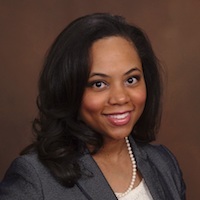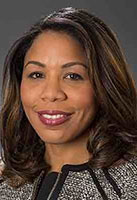
Latresa McLawhorn Ryan knows well the havoc that COVID has reaped upon small businesses of color in the Atlanta area and believes the effects of COVID are likely to hang over these businesses for some time.
She also knows that small businesses of color can bounce back if they get the right kind of assistance.
“We’ve lost a lot of businesses, some that were really anchors in their community,” said McLawhorn Ryan, executive director of the Atlanta Wealth Building Initiative, a nonprofit organization of community investors, advocates, and activists that supports Black-owned firms. She added that the casualties have included yoga studios, restaurants, and other businesses that rely on high traffic and face-to-face interaction. “It will take three to five years, depending on the sector, for businesses to recover from the impact of COVID.”

Latresa McLawhorn Ryan. Photo courtesy of the Atlanta Wealth Building Initiative
Because small businesses of color are an important driver of employment and asset building in their communities, the COVID-related business failures send a message throughout the community that perhaps it is more vulnerable to market forces, McLawhorn Ryan added.
The Federal Reserve Banks of Atlanta and Kansas City published a recovery guide in late 2020 to offer strategies that can help small businesses of color bounce back from the COVID crisis. The guide begins by discussing the state of small businesses of color before the COVID-19 pandemic, placing these firms’ challenges into historical context. A second section provides recommendations for communities looking to assist small businesses of color in the areas of credit and capital, education and training, policy, and community support. The final section shares tools for communities to develop an entrepreneurship network focused on small businesses of color.
Atlanta Fed president Raphael Bostic led a January 14 panel discussion with Southeast community leaders discussing ways to support small businesses. The webinar focused on the need to establish networks that can deliver resources and coaching.
Issue number 1 is funding
Janelle Williams, a senior adviser in the Atlanta Fed’s Community and Economic Development group who wrote the recovery guide with two Kansas City Fed advisers, said businesses owned by nonwhites face especially daunting challenges to regain their footing, with access to funding and credit topping the list.

The Atlanta Fed’s Janelle Williams. Photo by David Fine
“There are still structural barriers that limit small businesses of color from securing the capitalization needed to sustain and scale their businesses in a valuable way,” she said.
Much of the funds approved by U.S. lawmakers last year under the Paycheck Protection Program (PPP) to help businesses preserve employment did not reach the smallest companies and many firms owned by people of color. For example, a Federal Reserve Bank of New York analysis found that PPP loans were given to just 20 percent of eligible companies in states with the highest densities of Black-owned firms. In Fulton County, Georgia—which includes the city of Atlanta—a total of 20.8 percent of businesses received loans from the program. In Florida’s Miami-Dade County, just 15 percent of eligible firms obtained PPP funds.
In mid-January, a third round of PPP loans opened. Small business owners of color are hopeful that more funds will reach them this time. A portion of the $284 billion approved for small businesses in the December 2020 COVID relief legislation was set aside for firms with 10 or fewer employees and lenders that cater to underserved communities, including minority-owned banks and community development financial institutions.
Small businesses of color face barriers that make it harder to gain access to capital. They often lack relationships with traditional banks and access to social networks that could help them learn about and apply for available loans. Most entrepreneurs of color don’t have family wealth that could be used to start a business.
Other factors hinder the success of nonwhite small businesses. Williams noted research showing that in the six southeastern states that are part of the Atlanta Fed’s coverage area, small businesses of color are overrepresented in sectors such as food services and retail that have been particularly vulnerable during the pandemic because of required lockdowns, social distancing guidelines, and lower demand for goods and services.
“There is a need for a broader conversation around addressing barriers to entry for small businesses of color that seek to access higher-growth industries that are moderately insulated from market pressures,” Williams said.
Different approaches to financing
The tougher path to viability that small businesses of color face has been well documented. A 2017 report from Prosperity Now, a public policy nonprofit group, notes that deep and persistent patterns of racial discrimination against business owners of color have resulted in greater loan denials and higher interest rates for loans they do obtain. Those financing outcomes result in lower profit margins and limit the opportunities for businesses of color to build thriving enterprises.
The Reserve Banks’ recovery guide notes that the needs of small businesses of color call for financing methods that are nimbler and more accessible to help level the playing field. Those could include interest-free loans, loans with rates that start low and gradually rise, deferred payments and longer repayment time frames, and flexible underwriting terms. Many community organizations consulted in developing the recovery guide “shared that grants, forgivable loans, and patient equity capital will be needed” to help these businesses spring back, the report states.
Williams said the pandemic has challenged the funders that support small businesses of color to think about the kinds of financial assistance that would be meaningful and to understand that some types of aid may not help. “Small businesses of color already are debt averse, so asking them to incur additional debt is a challenge, especially when many rely on their personal income to stay afloat,” she said.
To address these issues, community stakeholders have begun to embrace alternate financing solutions, Williams said. She noted that philanthropic groups were offering program-related investments that provide capital at lower interest rates, while community development financial institutions were introducing funding products that include opportunities for credit enhancement.
The Atlanta Wealth Building Initiative launched a COVID relief fund last year that has provided money to at least 65 small businesses and 18 nonprofits, mainly located in the northwest, southwest, and southeast parts of metro Atlanta where residents’ health and personal income both suffered acutely. The program offers loans that include flexible terms, a six-month grace period, and 30 months of repayment. Through three rounds of grants and two rounds of loans to date, the nonprofit group has dispersed about $800,000 to Black-owned businesses, McLawhorn Ryan said.
The grants and loans have helped in many ways. One restaurant, for example, used a loan from the nonprofit to acquire a food truck that enabled it to sell in different communities and expand its customer base, she said.
“All of our loans were accompanied by specific technical assistance—it helps to have capital, but it also helps to have access to expertise to help think through how to get to the next stage or how to manage cash flow,” McLawhorn Ryan noted.
McLawhorn Ryan said it’s important for funding partners to keep offering funding and general support that will enable small businesses of color to recover and advance to the next phases of development, and she cautioned against a return to business as usual over the next few years.
“This is a new economy, and therefore it requires a new perspective,” McLawhorn Ryan said. “If we are intentional about creating inclusive products, inclusive opportunities for businesses to thrive and survive during this time, we have to be dedicated to the tools that are needed to create a truly equitable environment.”




